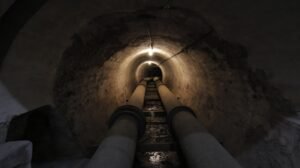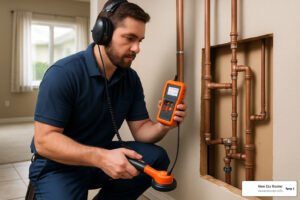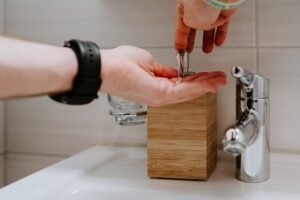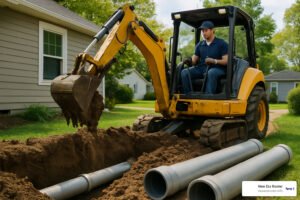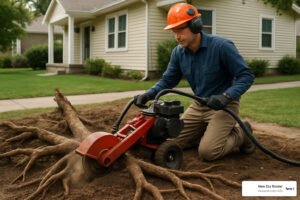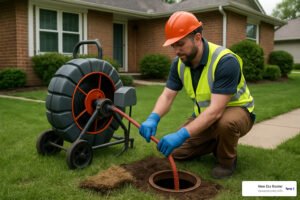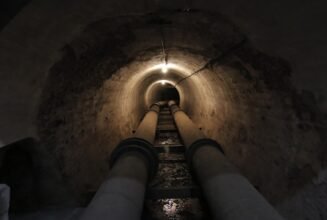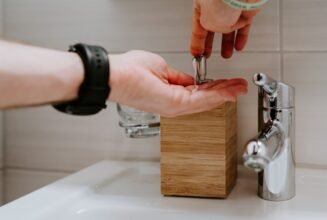Why Sewer Line Repair Can’t Wait When Your Home’s Health Is at Risk
Sewer line repair is essential when you notice multiple drains backing up, sewage odors in your yard, or gurgling sounds from your plumbing fixtures. Here are the main repair options:
- Camera Inspection + Hydro-Jetting: $235-$1,350 for diagnosis and cleaning
- Trenchless Pipe Lining: $80-$250 per foot, lasts 50+ years, minimal yard damage
- Pipe Bursting: $60-$200 per foot, full replacement without trenches
- Traditional Excavation: $50-$250 per foot, requires digging up your yard
- Spot Repairs: Lower cost for localized damage, shorter lifespan
Your sewer line is the largest drain in your home, carrying all wastewater from toilets, sinks, and showers to the city sewer system through gravity flow. When it fails, the results are immediate and messy.
The warning signs are hard to miss: flooded spots in your yard that smell like sewage, multiple fixtures backing up at once, or that unmistakable gurgling sound when you flush. As one Lake Elsinore homeowner finded, “An overflowing toilet is not something you want in your house!”
Don’t wait until sewage backs up into your home. Sewer problems only get worse over time, and what starts as a $300 cleaning can quickly become a $15,000 emergency replacement if you ignore the early signs.
The good news? Modern trenchless repair methods can fix most sewer line problems in less than a day without destroying your landscaping. But first, you need to understand which solution fits your specific situation and budget.

Find more about sewer line repair:
5 Practical Sewer Line Repair Solutions (Pros, Cons & Costs)
When your sewer line fails, you need to act fast. But with so many repair options available, how do you choose the right one? Let’s break down each method with real costs, expected lifespans, and honest pros and cons.
What causes sewer line damage in the first place? The main culprits are tree root intrusion, pipe corrosion (especially in older cast iron and clay pipes), extreme temperature changes that crack pipes, and debris buildup from improper disposal of grease and non-flushable items.
Most homeowners have between 25-100 feet of sewer line, which means replacement costs can range from $1,250 to $25,000 depending on the method you choose. Here’s how each solution stacks up:
Diagnose First: Camera Inspections & Hydro-Jetting
Before any sewer line repair work begins, we need to see what’s actually happening inside your pipes. This isn’t guesswork – it’s precision diagnostics.
Sewer Camera Inspection ($235-$1,350)
We insert a high-definition waterproof camera through your cleanout or toilet to create a complete video map of your sewer line. You can watch the footage with us on a mobile device, seeing exactly where roots have invaded, where pipes have cracked, or where debris has accumulated.
The inspection reveals:
- Exact location of blockages or damage
- Pipe material and condition
- Root intrusion patterns
- Structural integrity issues
- Scale buildup and corrosion
Hydro-Jetting ($300-$800)
This eco-friendly cleaning method uses high-pressure water streams to scour away years of grease, scale, and debris. It’s like power-washing the inside of your pipes, restoring them to nearly original diameter and flow capacity.
Pro tip: Always clean before lining. If you’re planning trenchless repairs, hydro-jetting first ensures the new liner adheres properly and lasts its full 50+ year lifespan.

Spot Cleaning & Descaling
Sometimes you don’t need a complete sewer line repair – just targeted cleaning or minor repairs to get your system flowing again.
Mechanical Rooter Service ($150-$400)
Our motorized spinning-blade rooters cut through root masses and clear stubborn clogs. This is often the first line of defense for simple blockages, though it’s typically a temporary fix for root problems since the roots will grow back.
Descaling and Brush Coating ($500-$1,500)
For pipes with heavy mineral buildup or minor corrosion, we can mechanically descale the interior walls and apply protective coatings. This extends pipe life by 10-15 years but isn’t a permanent solution for severely damaged lines.
When spot repairs work best:
- Single localized blockage
- Minor root intrusion
- Recent pipe installation (less than 20 years old)
- Budget constraints requiring temporary fixes
The downside? These are often short-term solutions. If your camera inspection reveals multiple problem areas or structural damage, you’ll likely need more comprehensive repairs within 2-3 years.
Trenchless Pipe Lining — A 50-Year Sewer Line Repair
This is where sewer line repair gets exciting. Trenchless pipe lining, also called Cured-In-Place Pipe (CIPP), creates a brand new pipe inside your old one without any digging.
How it works:
- We clean your existing pipe with hydro-jetting
- Insert a resin-saturated felt liner through small access points
- Inflate the liner against the old pipe walls
- Cure it in place using heat or UV light
- The result: a seamless, jointless new pipe that lasts 50+ years
Cost: $80-$250 per linear foot
For a typical 50-foot residential sewer line, expect to pay $4,000-$12,500.
Advantages:
- Completed in one day
- No yard excavation
- 50+ year lifespan with warranty
- Root-resistant and chemical-resistant
- Minimal property disruption
- Can steer bends and turns
Limitations:
- Requires existing pipe to be structurally sound
- Can’t fix completely collapsed sections
- Slightly reduces pipe diameter (usually negligible)
- More expensive upfront than spot repairs
Scientific research on cured-in-place technology shows CIPP liners can actually increase pipe strength and flow capacity compared to deteriorated original pipes.
Pipe Bursting — Full Replacement Without a Trench
When your sewer line is beyond repair but you want to avoid massive excavation, pipe bursting offers the best of both worlds: complete replacement with minimal digging.
The process:
- We dig small entry and exit pits at each end of your sewer line
- Insert a pneumatic bursting head attached to new HDPE pipe
- The bursting head fractures your old pipe while simultaneously pulling in the new one
- Reconnect to your home’s plumbing and the city connection
- Restore small surface areas
Cost: $60-$200 per linear foot
Total project costs typically range from $6,000-$15,000 for most homes.
Why we love pipe bursting:
- Completely new pipe system
- HDPE pipes resist roots, corrosion, and shifting soil
- 100+ year expected lifespan
- Larger diameter options available
- Works even with completely collapsed pipes
Best for:
- Severely damaged or collapsed sewer lines
- Upgrading pipe size for better flow
- Clay or cast iron pipes with multiple failure points
- Properties where full excavation isn’t feasible

Traditional Excavation — The Old-School Sewer Line Repair
Sometimes there’s no substitute for the tried-and-true dig-and-replace method. While it’s the most disruptive option, traditional excavation remains necessary in certain situations.
When excavation is required:
- Sewer line runs under structures or hardscaping
- Severe pipe misalignment or bellying
- Local code requirements for new construction
- Multiple utility conflicts
- Soil conditions unsuitable for trenchless methods
Cost: $50-$250 per linear foot
Add $30-$70 per cubic foot for excavation and backfill, plus landscaping restoration costs.
The full process:
- Utility location and permit acquisition
- Excavate trenches 4-8 feet deep (with proper shoring for safety)
- Remove old pipe sections
- Install new PVC pipe with proper slope (1/4 inch per foot)
- Backfill and compact soil
- Restore landscaping and hardscaping
Total project timeline: 3-7 days
Much longer than trenchless methods, and your yard will look like a construction zone during the process.
Here’s a comparison of your main options:
| Method | Cost Per Foot | Lifespan | Disruption | Timeline |
|---|---|---|---|---|
| Trenchless Lining | $80-$250 | 50+ years | Minimal | 1 day |
| Pipe Bursting | $60-$200 | 100+ years | Low | 1-2 days |
| Traditional Excavation | $50-$250 | 75-100 years | High | 3-7 days |
The bottom line: While excavation has the lowest per-foot cost, when you factor in landscaping restoration, permit fees, and the value of your time, trenchless methods often provide better overall value.
Choosing the Right Sewer Line Repair & Preventing Future Problems
Picking the perfect sewer line repair solution feels overwhelming when you’re dealing with sewage problems. But here’s the thing – the “best” method isn’t always the most expensive one. It’s the one that matches your home’s unique situation and gives you peace of mind for years to come.
What really matters when making this decision? Let’s walk through the key factors that should guide your choice.
Your line length and depth play a huge role in costs. If your sewer line runs shallow (less than 4 feet deep), you’ve got options. But when we’re talking about lines buried 6+ feet down, trenchless methods suddenly become your wallet’s best friend. Nobody wants to pay for massive excavation when you don’t have to.
For longer runs over 75 feet, pipe bursting often wins the cost-effectiveness contest. It’s like getting a brand new sewer system without turning your yard into an archaeological dig site.
Your pipe’s age and material tell the whole story. Those old cast iron pipes that have been faithfully serving your home for 75+ years? They might be perfect candidates for trenchless lining if they’re still structurally sound. Clay pipes, on the other hand, seem to send out personal invitations to every tree root in the neighborhood – they often need complete replacement.
Here’s something that surprises many homeowners: Orangeburg pipes (those fiber pipes used from the 1940s-70s) usually can’t be saved. They’ve earned the nickname “no-corrode pipe,” but time hasn’t been kind to them.
Your soil type matters more than you might think. If you’re dealing with expansive clay soils that shift and move, flexible HDPE pipes from pipe bursting handle that movement like champs. Sandy soils are the easy-going type – they work well with any repair method.
Insurance and home warranty coverage can be tricky territory. Most standard homeowners insurance won’t cover sewer line repair unless it’s damage from a covered event (like a tree falling on your line). However, more home warranty plans are starting to include sewer line protection. Check your coverage before you choose a contractor – some policies require specific repair methods or pre-approved contractors.

The best sewer line repair is the one you never need. Sounds cheesy, but it’s absolutely true. A little prevention goes a long way toward protecting your investment and avoiding emergency situations.
Your annual maintenance schedule doesn’t have to be complicated. For homes over 25 years old, a video inspection every 3-5 years helps catch problems before they become disasters. If you’re battling recurring root problems, hydro-jetting every 2-3 years keeps those invasive roots in check.
Monthly enzyme treatments might sound like overkill, but they work quietly in the background, breaking down grease and organic buildup that can cause major headaches later.
Tree management is where many homeowners make expensive mistakes. That beautiful oak tree you planted 20 years ago? Its root system now extends 2-3 times wider than its canopy. The golden rule: plant new trees at least 10 feet away from your sewer line. For existing problem trees, root barriers can help, though sometimes removal is the only long-term solution.
Your daily habits make a bigger difference than you might realize. Proper usage means treating your sewer system with respect – only toilet paper and human waste go down the toilet, cooking grease goes in the trash (not down the drain), and those chemical drain cleaners stay on the store shelf where they belong.
Here’s something that keeps us up at night: the health risks of delayed repairs. Scientific research on sewer-gas health risks shows that exposure to sewer gases can cause headaches, dizziness, and respiratory problems. But the real danger comes from sewage backups, which create serious health hazards from bacteria, viruses, and parasites.
Don’t gamble with your family’s health. What looks like a minor sewer problem can escalate frighteningly fast, especially during heavy rains when municipal systems are already stressed to their limits.

Need Help Now? New Era Rooter’s 24/7 Team Has You Covered
When your sewer line decides to call it quits, you need professionals who can diagnose the problem accurately and fix it right the first time. At New Era Rooter, we’ve been solving sewer line repair emergencies throughout Lake Elsinore and surrounding areas with our 24/7 emergency service.
Here’s what sets our team apart: We start every job with a free video inspection so you can see exactly what’s wrong before we start any work. No surprises, no guesswork – just honest assessment of your situation.
We’re not locked into one repair method, which means you get recommendations based on what’s actually best for your home, not what’s most profitable for us. Whether you need simple hydro-jetting or complete pipe replacement, we’ve got the tools and expertise to handle it.
Financing options help spread the cost over manageable monthly payments because we know sewer emergencies don’t wait for payday. Our long-term warranties mean we stand behind our work with comprehensive guarantees that give you real peace of mind.
Most importantly, emergency response is available 24/7 because sewage backups don’t respect business hours, and neither do we.
We serve Point Loma, San Diego, Lake Elsinore, Temecula, Chula Vista, National City, Escondido, Claremont, Spring Valley, Fallbrook, and Lemon Grove with the same commitment to quality and customer service.
We understand that sewer line repair is never planned, never convenient, and never fun. That’s exactly why we work quickly to minimize disruption to your daily routine while making sure the job is done right the first time.
Ready to solve your sewer problems permanently? Contact New Era Rooter today for your free inspection and honest assessment of your repair options. Don’t let a small problem snowball into a major disaster – we’re here to help around the clock.
More info about sewer services
Here’s the bottom line: The national average for sewer line replacement hovers around $5,000, but with proper diagnosis and the right repair method, many problems can be solved for much less. The secret is acting quickly when you notice those warning signs and working with experienced professionals who guide you toward the most cost-effective solution.
Your home’s sewer system is too critical to leave to chance. With modern trenchless repair methods, most sewer line problems can be solved permanently in less than a day, protecting your property value and your family’s health for decades to come.



